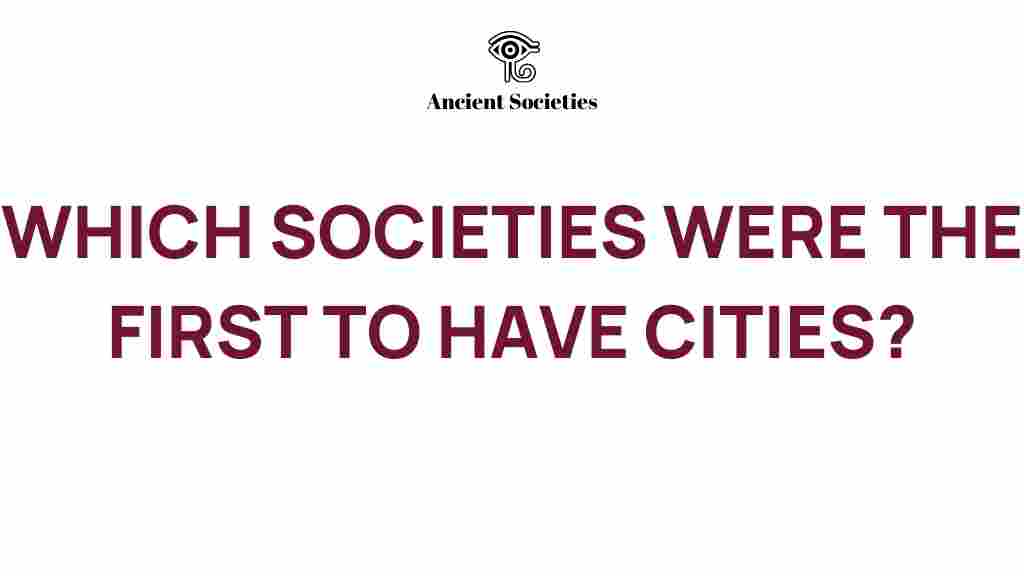Unveiling the Origins: Which Societies Built the First Cities?
The story of ancient cities is a fascinating one, steeped in the mists of time and the evolution of human civilization. As we delve into the history of cities, we uncover the intricate tapestry of urban development that has shaped societies throughout the ages. From the fertile plains of Mesopotamia to the bustling streets of later civilizations, the emergence of urban centers marks a significant turning point in the cultural evolution of humanity. This article explores the origins of the first cities, the societies that built them, and the archaeological evidence that sheds light on their development.
The Birth of Urban Centers in Mesopotamia
Mesopotamia, often referred to as the “Cradle of Civilization,” is widely recognized as the birthplace of the first ancient cities. Located between the Tigris and Euphrates rivers, this region saw the rise of advanced societies that laid the groundwork for urban life.
- Geographical Advantages: The fertile land and access to water made Mesopotamia an ideal location for agriculture, which supported larger populations.
- Societal Structures: As agricultural practices improved, surplus food allowed for the specialization of labor, leading to complex societal structures.
- Trade and Interaction: The cities in Mesopotamia became trade hubs, facilitating the exchange of goods and ideas between different societies.
The most prominent ancient cities in Mesopotamia include:
- Ur: Known for its impressive ziggurat and as a center for trade and culture.
- Babel: Famous for its legendary Tower of Babel, symbolizing the ambition and architectural prowess of its people.
- Nippur: A religious center that played a crucial role in the spiritual life of the region.
Key Factors in Urban Development
The transition from nomadic tribes to settled urban dwellers was driven by several key factors:
- Agricultural Innovation: The development of irrigation systems and farming techniques allowed populations to grow.
- Social Organization: The establishment of governance systems and social hierarchies contributed to the functioning of cities.
- Technological Advances: Innovations in tools, construction techniques, and crafts facilitated urban growth.
Archaeological Evidence of Ancient Cities
Archaeology plays a crucial role in understanding the history of cities. Excavations in Mesopotamia have revealed remarkable insights into the urban life of ancient societies:
- Artifacts: Tools, pottery, and inscriptions have provided evidence of daily life, trade, and cultural practices.
- Architectural Remains: The ruins of temples, houses, and public buildings illustrate the complexity of urban planning.
- Urban Layouts: The arrangement of streets and neighborhoods indicates how people interacted and organized their lives.
For more detailed archaeological insights, you can visit this resource.
Cultural Evolution and the Role of Religion
Religion played a pivotal role in the cultural evolution of ancient cities. Temples were often the focal points of urban life, serving as places of worship and community gatherings:
- Religious Practices: The worship of various deities influenced architecture, art, and societal norms.
- Rituals and Festivals: These events fostered community cohesion and reinforced social hierarchies.
The integration of religion into urban life not only shaped the identity of ancient cities but also established lasting traditions that influenced future civilizations.
Challenges Faced by Early Urban Societies
While the rise of ancient cities brought many advancements, it also presented challenges:
- Resource Management: As populations grew, the demand for resources increased, leading to potential conflicts.
- Environmental Changes: Shifts in climate and natural disasters could threaten agricultural productivity.
- Social Stratification: The emergence of distinct social classes often led to tension and inequality.
Lessons from the First Cities
The study of ancient cities provides valuable lessons for contemporary urban development:
- Sustainable Practices: The importance of resource management and environmental stewardship is critical in modern urban planning.
- Community Engagement: Building inclusive communities fosters social cohesion and resilience.
- Adaptability: Cities must be prepared to adapt to changing circumstances, whether environmental or social.
Conclusion: The Legacy of Ancient Urban Development
The first ancient cities, particularly those in Mesopotamia, laid the foundation for urban development as we know it today. Their emergence marked a significant milestone in the history of cities, showcasing the ability of human societies to innovate and adapt. As we look back on this rich history, we gain insights into the complexities of societal structures, cultural evolution, and the challenges that come with urbanization.
In understanding the origins of ancient cities, we not only celebrate the achievements of our ancestors but also reflect on the paths we must take to ensure sustainable and thriving urban environments for future generations. The exploration of these ancient urban centers will continue to inspire archaeologists, historians, and urban planners alike, as we seek to learn from the past in shaping the cities of tomorrow.
For those interested in diving deeper into the history of cities, visit this link for further reading.
This article is in the category Archaeology and created by AncientSocieties Team
